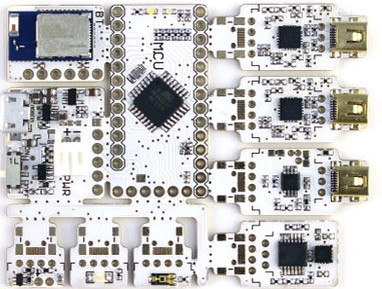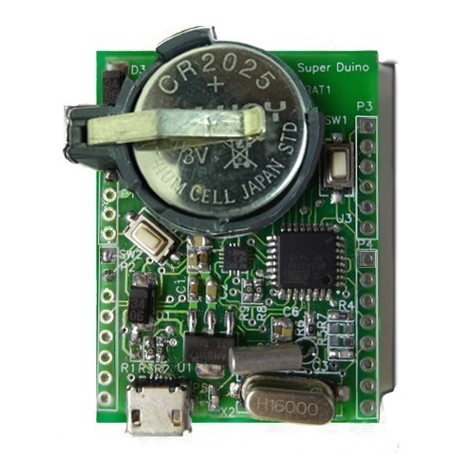This list is sew awesome!
Created by Leah Buechley of MIT, and introduced commercially with SparkFun back in 2007, the LilyPad was the first board to feature sew-through contacts for stitching soft circuits. Since then, a number of “ready-to-wear” electronics platforms have emerged, each of which have helped usher in a new generation of textiles that look to redefine wearable technology. In fact, a recent Gartner report revealed that the emergence smart garments will potentially disrupt the market. So much so that embedded clothing shipments are projected to rise from a mere 0.1 million units in 2014 to 26 million units in 2016.
As first noted by MAKE: Magazine’s Boris Kourtoukov, “there’s a plethora of options” when it comes to these microcontrollers. What’s more, they all possess one common trait: they’re powered by Atmel. These so-called body boards are now giving Makers the ability to easily (and affordably) produce their own projects in ways that otherwise would have been unimaginable.
So, without further ado, here’s a look at some of today’s most prominent boards ready for adornment.
The Favorites
LilyPad Arduino
LilyPad is a wearable e-textile technology developed by Leah Buechley and cooperatively brought to life with SparkFun. Each LilyPad was creatively designed to have large connecting pads to allow them to be sewn into clothing. LilyPad can sense information about the environment using inputs like light and temperature sensors and can act on the environment with outputs like LED lights, vibrator motors, and speakers. And yes, they’re even washable.
MCU: ATmega328
FLORA
FLORA is Adafruit’s fully-featured wearable electronics platform. The round, sewable microcontroller weighs in at 4.4 grams and measures only 1.75 inches in diameter. 100% Arduino-compatible, the platform is one of the most beginner-friendly ways to create some amazing wearables. The FLORA family includes an assortment of sensors and RGB LEDs that let you add lighting to your projects, not to mention also boasts built-in USB support, eliminating the need for pesky special cables and extra parts.
MCU: ATmega32U4
GEMMA
Those who are seeking the awesomeness of FLORA but in a tinier package are sure to love another one Adafruit’s wearable platforms: the GEMMA. The board, which packs all of its features in a 1″ diameter package, is programmable with an Arduino IDE over USB. An upcoming Arduino IDE-supported version will feature an on/off switch and microUSB connector.
MCU: ATtiny85
TinyLily Mini
A brainchild of TinyCircuits, the TinyLily Mini is an Arduino-compatible module in an ultra-compact package. Geared towards Makers looking to devise e-textile and wearable applications, the board is very similar to the Arduino LilyPad, with the same processing power and software compatibility – but at 1/12th of the size. The TinyLily Mini also is equipped with sew tabs for eight I/O (four digital, four analog/digital) and four power sew tabs (two for power, two for ground).
MCU: ATmega328
SquareWear
SquareWear is an open-source, wearable board. The Arduino-compatible MCU measures 1.7″x1.7″ in size, and is equipped with a built-in rechargeable Lithium coin battery. It is designed to be sewable, which allows Makers to stich conductive threads through its large pin pads, solder a wire directly onto the pads, or solder snaps onto the pads for quick attachment or detachment from textiles and fabrics. Additionally, the MCU packs an on-board miniUSB port that can be used for programming, charging batteries and serial communication, as well as a color LED, a pushbutton, a buzzer, a light and temperature sensor, and three MOSFETs to drive the high-current load. See, it’s hip to be square!
MCU: ATmega328
Xadow
Seeed Studio’s Xadow is a high-performance, low-power board that is perfectly suited for wearable projects. The microcontroller can be powered either via USB or a Lithium battery. Also, there is charge circuit on this module that you can charge for the Lithium battery through the USB port. Xadow has a diverse selection of compatible modules, including a barometer, UV sensor, LED, OLED and even a full GPS antenna.
MCU: ATmega32U4
Trinket
Trinket goes to show that big things really can come in small packages. In fact, the tiny MCU is one of the lowest-cost Arduino IDE programmable boards on the market today. Adafruit designed a USB bootloader so Makers could easily plug it into any computer and reprogram it over a USB port just like an Arduino. It comes in two different versions: 3V and 5V. Both work the same, but have different operating logic voltages.
MCU: ATtiny85
Pro Trinket
A bigger sibling of the aforementioned board, this 5V unit combines everything you love about Trinket along with the familiarity of the common core found in Arduinos. It’s like an Arduino Pro Mini with more pins along with built-in USB. The Pro Trinket, which still only measures 1.5″ x 0.7″ x 0.2” in size, features 18 GPIO, two extra analog inputs, 28K of flash, as well as 2K of RAM. Like its older brother, the MCU has onboard USB bootloading support and Optiboot support, so Makers can either program their Pro Trinket over USB or with a FTDI cable just like the Pro Mini. (Recently, paying homage to our friends at Hackaday, the Adafruit crew even unveiled a Hackaday.io branded board — black solder mask, Jolly Wrencher and all. And, it’s stunning.)
Atmel MCU: ATmega328
Ones to Watch
BITalino
BITalino is a low-cost, easy-to-use toolkit designed for anyone looking to build self-tracking applications based on information from their body. The platform enables Makers to quickly bring projects entailing body signals and quantified self wearable devices to life, as well as learn how to create actual medical devices — which otherwise can cost upwards of $10,000. BITalino is described by its creators as an out-of-the-box solution that offers an array of Arduino-compatible software and hardware blocks equipped with sensors for electrocardiography (ECG), electromyography (EMG), electrodermal Activity (EDA), accelerometry (ACC), and ambient light (LUX).
MCU: ATmega328
Printoo
Launched by Ynvisible, Printoo is a printed electronics prototyping platform that is capable of bringing everyday objects to life. Comprised of various hardware modules that can all be connected to each other, it is currently the only platform that appears to have a robust flexible form-factor. This enables Makers to quickly and seamlessly create first product concepts for smart wearable devices. Moreover, the board is fully-compatible and programmable with the Arduino IDE.
MCU: ATmega328
SuperDuino
Introduced by Maker Mohsin Farooq, SuperDuino is a coin cell operated, Arduino-compatible board with a built-in 1.7-inch color display and a three-axis accelerometer. As you can imagine, this makes the MCU a suitable match for a wide-range of DIY games, gadgets and most of all, wearable devices.
MCU: ATmega328






















